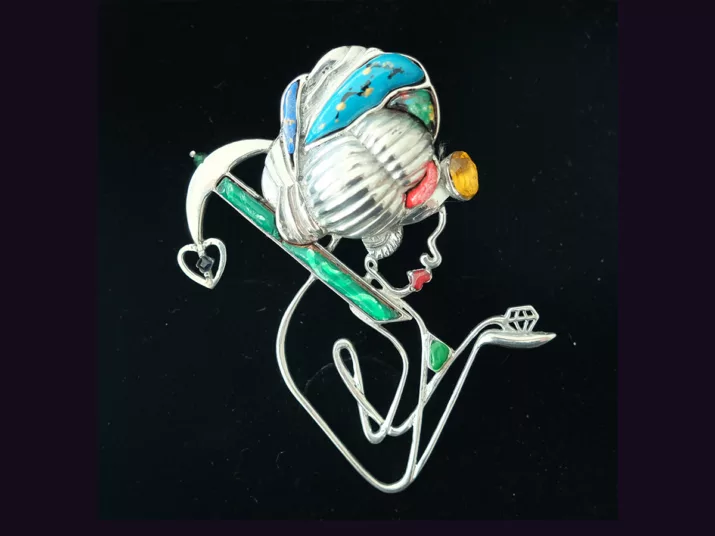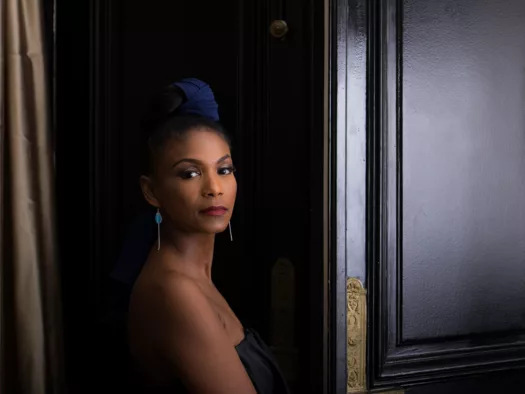
The piece on display at Futurium in Berlin is a prototype of the Lady Aya brooch in 925 sterling silver. Photo: Ludmilla Ostermann
The Fairy of the Mines: The Making of Lady AYA
A very special treasure now adorns the Futurium exhibition: a prototype of the Lady AYA brooch of the Association of Women in Mining in Africa (AWIMA). The brooch is a vision of how jewellery could be produced in the future under fair conditions for everyone involved.

The piece on display at Futurium in Berlin is a prototype of the Lady Aya brooch in 925 sterling silver. Photo: Ludmilla Ostermann
Women in mining
Around the globe, women work at different levels in the extractive industries, taking on a range of different responsibilities. However, the differences between these women are huge. Worldwide, in large-scale industrial mining, only eleven per cent of companies are run by women.
In countries such as Canada and Australia, less than a fifth of all employees in the industry are women, with most females working in administrative jobs. The situation is completely different in artisanal and small-scale mining. It is estimated that one in three mining workers worldwide are female; in some African countries, artisanal and small-scale mining is performed almost exclusively by women – usually under physically demanding and unhealthy conditions. Normally, their wages are also significantly lower than those of men.
The Association of Women in Mining in Africa (AWIMA) is committed to building a responsible and fairer extractive industries sector for women in Africa. Their goals are to improve training and working conditions, to enable women to access loans and to bring more women into the top jobs in the mining companies.
The AWIMA Jewellery Project
AWIMA Jewellery is an initiative that aims to bring together African women from the entire jewellery industry. From mine owners to traders, gem cutters and jewellers, the project wants to promote collaboration and empower women along the entire supply chain.
AWIMA Jewellery provides women with a platform to make contacts, exchange resources and learn skills. In this way, the project contributes to eliminating the gender imbalance in the jewellery industry.
The Designer
Ngoné Sagna was born in Senegal and has lived and worked in Paris for more than 30 years. Senegalese culture, with its elegance and sense of form and colour, has influenced her since childhood. The history of the African continent is reflected in her works as a result. Above all, she celebrates the queens and heroines of Africa over and over again in her creations. Sagna trained as a jeweller with Parisian craftspeople and is a graduate of Nicolas Flamel’s jewellery school in Paris. Her passion for jewellery reveals a creativity rooted in the aesthetic heritage of Africa, reinvented with modern and universal codes.

Photo: Aymeric Ai
The details of the brooch
Wealth and unity: the voluminous headdress made of gold and set with precious stones symbolises Africa’s wealth of natural resources.
Sublimity: as the queen of the mine, the female figurine in the brooch carries her pickaxe like an Egyptian sceptre.
Resilience: AYA, the Adinkra fern symbol, is an ancient Asante symbol of perseverance and ingenuity. The fern is known to be a hardy plant, and Lady Aya wears this symbol as earrings. “An individual who wears this symbol suggests that he has endured many adversities and outlasted much difficulty.” (Willis, The Adinkra Dictionary)
Courage and strength: the Adinkra symbol of courage appears as a tanzanite gemstone adorning the pendant on the pickaxe.
Connection to jewellers and manufacturing: in her hand, the lady holds a representation of the diamond, cut as a precious stone and magically ready for production.
Diversity: the gemstones on the brooch come from different African countries and were also chosen for their symbolism and diversity, representing Pan-Africanism. In keeping with the joyfully colourful African way of life, they add a harmony of colour to the design. The gems contrast with the golden metal body and the mine-shaped layers of the figurine’s turban head.
Designing Lady AYA
Inspired by Moorish brooches, designer Ngoné Sagna created Lady Aya as the personified signature of the African motherland. As an allusion to the continent’s soil, which is rich in mineral resources, the golden figurine’s turban headdress is artfully knotted and set with a sapphire gemstone at the front.
“Aya is the lady and fairy of the mines. She never leaves the house without her jewellery, especially the earrings with the Adinkra symbol in white gold, which she wears as an ancient sign of perseverance and ingenuity,” Sagna explains. “She has all the qualities needed to fulfil her task successfully. Armed with courage, the mine fairy works hard and looks at the fruits of the community’s labour with humility and pride.”